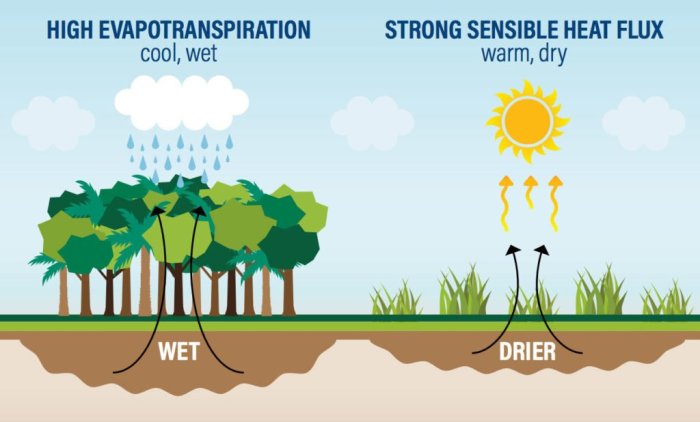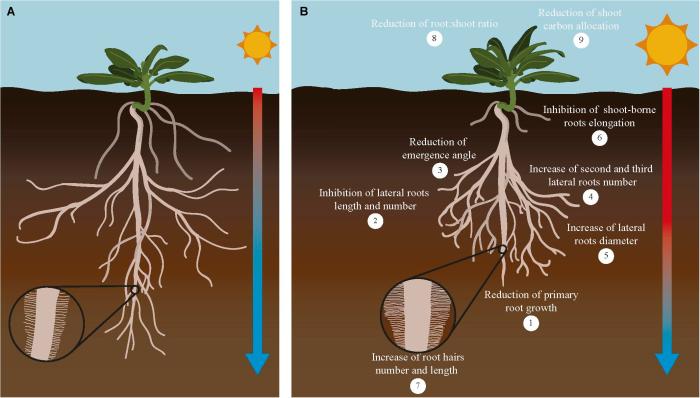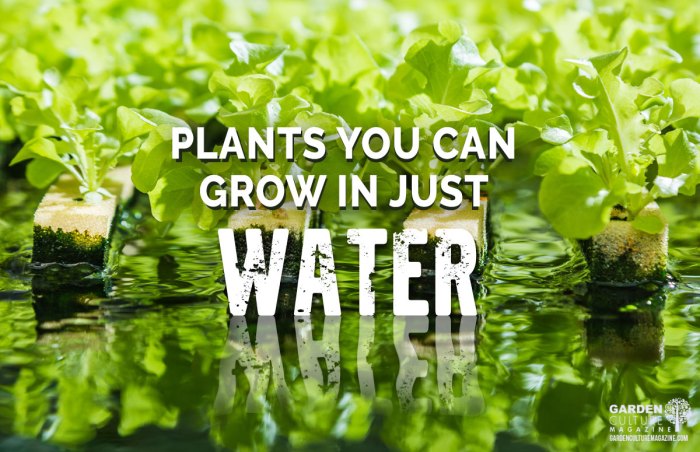How Does Water Affect Plant Growth?
Water Uptake and Transport in Plants
How does water affect plant growth – Water is essential for plant survival and growth, acting as a solvent for nutrient transport and playing a crucial role in various physiological processes. Understanding how plants absorb and transport water is fundamental to comprehending their overall health and productivity.
Osmosis and Water Absorption
Plants absorb water primarily through their roots via osmosis. Osmosis is the movement of water across a semi-permeable membrane from a region of high water potential (low solute concentration) to a region of low water potential (high solute concentration). Root hairs, with their large surface area, increase the efficiency of water absorption. The concentration of solutes within root cells is lower than the concentration in the surrounding soil water, creating a water potential gradient that drives water into the roots.
Water Movement from Roots to Leaves
Once absorbed, water travels through the plant via a pathway involving several tissues. Water moves from the root cortex, through the endodermis (a layer of cells regulating water entry into the vascular system), and into the xylem. Xylem vessels, composed of dead, lignified cells, form a continuous network extending from the roots to the leaves. Water is transported upwards through the xylem due to a combination of forces including root pressure, capillary action, and transpiration pull (the upward movement of water caused by evaporation from leaves).
Water Uptake in Different Plant Types
Different plant types have adapted different mechanisms for water uptake depending on their environment. Hydrophytes (water plants) are submerged in water and absorb water directly through their entire surface. Mesophytes (plants adapted to moderate water conditions) absorb water primarily through their roots. Xerophytes (plants adapted to arid conditions) have specialized adaptations, such as reduced leaf surface area, thick cuticles, and deep root systems, to minimize water loss and maximize water uptake.
Plant Tissues Involved in Water Transport
| Tissue Type | Location | Function | Cell Characteristics |
|---|---|---|---|
| Root hairs | Root epidermis | Increase surface area for water absorption | Elongated, thin-walled cells |
| Cortex | Root interior | Pathway for water movement to the vascular cylinder | Parenchyma cells with intercellular spaces |
| Endodermis | Layer surrounding vascular cylinder | Regulates water and solute movement into the xylem | Cells with Casparian strips (impermeable bands) |
| Xylem | Vascular bundles | Transports water and minerals from roots to leaves | Long, hollow, lignified cells (vessels and tracheids) |
Water’s Role in Photosynthesis
Water is a critical reactant in photosynthesis, the process by which plants convert light energy into chemical energy in the form of glucose. Its role is not merely as a solvent, but as a direct participant in the process.
Water in Light-Dependent Reactions
In the light-dependent reactions of photosynthesis, water molecules are split during a process called photolysis. This process releases electrons, which are essential for the electron transport chain that generates ATP (adenosine triphosphate) and NADPH (nicotinamide adenine dinucleotide phosphate), energy-carrying molecules used in the subsequent light-independent reactions.
Water Deficiency and Photosynthesis
Water deficiency significantly reduces the rate of photosynthesis. Without sufficient water, stomata (pores on leaves) close to prevent water loss, reducing the intake of carbon dioxide, a crucial reactant in photosynthesis. Furthermore, a lack of water can damage the photosynthetic machinery itself, further impairing the process.
Photolysis and Water Usage

Source: eagrovision.com
Photolysis, the splitting of water molecules, is crucial because it provides the electrons needed to replace those lost by chlorophyll during the light-dependent reactions. Oxygen, a byproduct of photolysis, is released into the atmosphere. The hydrogen ions produced during photolysis contribute to the generation of ATP via chemiosmosis.
Water Usage in Photosynthesis: A Flowchart
The following steps illustrate water usage during photosynthesis:
- Water is absorbed by roots via osmosis.
- Water is transported to leaves via xylem.
- Water enters the thylakoid membranes within chloroplasts.
- Photolysis occurs: water is split into oxygen, hydrogen ions, and electrons.
- Electrons are used in the electron transport chain.
- Hydrogen ions contribute to ATP synthesis.
- Oxygen is released as a byproduct.
Water and Plant Turgor Pressure: How Does Water Affect Plant Growth
Turgor pressure, the pressure exerted by water within a plant cell against its cell wall, is vital for maintaining plant structure and function. It’s the force that keeps plants upright and their leaves firm.
Turgor Pressure and Plant Structure
When plant cells are adequately hydrated, they are turgid, meaning they are firm and swollen due to high turgor pressure. This pressure provides structural support, particularly in herbaceous plants that lack woody tissue. Loss of turgor pressure leads to wilting, as cells become flaccid (limp).
Water is crucial for plant growth, transporting nutrients and maintaining turgor pressure. However, the type of water matters; to understand this better, consider whether you should use purified water, which leads to the question: can you use distilled water for plants ? The answer influences how effectively water contributes to a plant’s overall health and development, impacting its ability to thrive.
Water Availability and Turgor Pressure
Water availability directly influences turgor pressure. Sufficient water ensures high turgor pressure, maintaining plant rigidity. Water stress reduces turgor pressure, leading to wilting and potentially irreversible damage.
Effects of Water Stress and Excessive Watering
Both water stress and excessive watering negatively impact turgor pressure. Water stress leads to decreased turgor, wilting, and reduced growth. Excessive watering can lead to root hypoxia (lack of oxygen), inhibiting water uptake and causing reduced turgor.
Symptoms of Under-watering and Over-watering, How does water affect plant growth
| Symptom | Under-watering | Over-watering | Plant Response |
|---|---|---|---|
| Wilting | Leaves droop and become limp | Leaves may droop initially, then yellow and die | Reduced turgor pressure; potential irreversible damage |
| Leaf color | Leaves may turn brown and crispy | Leaves may turn yellow or brown, often starting from the bottom | Chlorosis (loss of chlorophyll); tissue death |
| Soil moisture | Dry soil | Soggy, waterlogged soil | Reduced water and nutrient uptake; root rot |
| Growth rate | Stunted growth | Stunted growth; potential root rot | Reduced cell expansion and overall development |
Water and Plant Growth Processes

Source: frontiersin.org
Water plays a crucial role throughout a plant’s life cycle, influencing various growth stages from seed germination to fruit production. The availability of water significantly impacts the success and rate of these processes.
Water’s Role in Key Growth Stages
Water is essential for seed germination, enabling the embryo to swell and break through the seed coat. It is also critical for root development, stem elongation, leaf expansion, flowering, and fruit development. Water availability at each stage directly influences the overall growth and yield of the plant.
Water Availability and Growth
Adequate water ensures proper cell expansion and elongation, leading to robust growth. Insufficient water during seed germination can prevent germination altogether. Water stress during root development limits root growth, reducing the plant’s ability to absorb water and nutrients. Similarly, water stress during stem elongation results in stunted growth and weak stems. Examples include smaller corn plants under drought conditions versus those with adequate watering.
Water Stress and Flowering/Fruit Production
Water stress can significantly impact flowering and fruit production. Plants under stress may produce fewer flowers, resulting in reduced fruit yield. The fruits produced may be smaller and of lower quality. For example, drought conditions can reduce the size and sugar content of tomatoes.
Impact of Varying Water Levels on Plant Growth
Imagine three tomato plants: one well-watered, one moderately watered, and one severely water-stressed. The well-watered plant will be tall and robust with large, dark green leaves, and numerous, plump fruits. The moderately watered plant will be smaller with slightly paler leaves and fewer, smaller fruits. The water-stressed plant will be stunted, with yellowed, wilted leaves, and very few, small, and possibly malformed fruits.
Water Quality and Plant Growth

Source: hamanol.com
The quality of water used for irrigation significantly impacts plant growth. Factors such as pH, salinity, mineral content, and pollutants can all affect nutrient uptake and overall plant health.
pH and Nutrient Uptake
The pH of water influences the availability of nutrients in the soil. Different nutrients have optimal pH ranges for uptake. For example, iron is less available at high pH levels, leading to iron deficiency in plants. Maintaining an appropriate pH range is essential for optimal nutrient absorption.
Salinity and Mineral Content
High salinity levels in irrigation water can negatively affect plant growth. Excess salts can interfere with water uptake by roots and damage plant tissues. Similarly, an imbalance or deficiency of essential minerals in the water can lead to nutrient deficiencies, affecting plant growth and development.
Different Water Sources and Plant Growth
Different water sources, such as tap water, rainwater, and distilled water, can have varying effects on plant growth. Tap water may contain chlorine and other chemicals that can harm plants. Rainwater is generally considered a good source of water, but its mineral content can vary depending on location. Distilled water lacks minerals, potentially leading to nutrient deficiencies.
Water Pollution and Plant Growth
Water pollution from industrial waste, agricultural runoff, and sewage can severely impact plant growth. Pollutants can contaminate the soil and water, inhibiting nutrient uptake, damaging plant tissues, and leading to reduced growth and yield. Heavy metals, for instance, can accumulate in plant tissues, causing toxicity.
FAQ Guide
What happens if a plant receives too little water?
Underwatering leads to wilting, stunted growth, leaf browning, and potentially plant death due to insufficient water for essential processes.
What happens if a plant receives too much water?
Overwatering can cause root rot, nutrient deficiencies, and fungal diseases, hindering growth and potentially killing the plant.
Can different types of water affect plant growth?
Yes, the pH, mineral content, and presence of pollutants in water sources like tap water, rainwater, or distilled water can significantly influence plant health and growth.
How does water affect flowering and fruiting?
Adequate water is crucial for flower and fruit development. Water stress can reduce flower production and fruit size, while excessive watering can negatively impact fruit quality.
How can I determine the optimal watering schedule for my plants?
Consider factors like plant type, pot size, soil type, and environmental conditions (temperature, humidity, sunlight) to determine the appropriate watering frequency and amount. Checking soil moisture regularly is crucial.




















